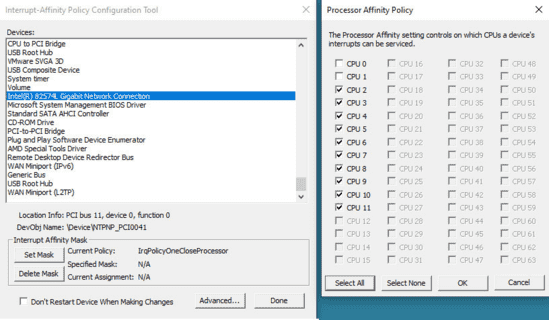Microsoft Interrupt Affinity Tool
Microsoft Interrupt Affinity Tool
-
272.0 KB
Installer
Interrupt_Affinity_Policy_Tool.msiMD5:5855346C2A0A89242FC9DEEECB94AD9DSHA1:083693CB04F64438820E119AAE14BB48EE907602SHA256:4543469631C4E2A90253B1214C73FBA326E8705792A0267AE559FD97A019E3C0
The Microsoft Interrupt-Affinity Policy Tool (IntPolicy) is a software that allows you to "bind" or change the CPU affinity of the interrupts for a given device (such as a network adapter or GPU) to a specific CPU core, processor or processors on a multiprocessor computer.
This binding is also referred to as partitioning. The binding of interrupts from a specific device to specific processors ensures running deferred procedure calls (DPCs) and interrupt service routines (ISRs) for the device on the designated processors. This can also help reduce the DPC Latency of graphics cards from NVIDIA and AMD.
Note that interrupt affinity cannot be configured on computers with a single-core processor.
The default behavior of Windows is to assign device interrupts to any available processor. When interrups are bound/partitioned to run on a specific set of CPUs, rather than any available processor, the performance and scalability of the associated device might be improved.
Interrupt-binding using IntPolicy should always be evaluated in a test environment before employing in a production environment. The hardware, operating system and application configuration of the test environment should approximate the production environment as closely as possible. This will allow you to test various permutations of interrupt-binding and determine the extent that interrupt-binding will increase performance.
You may want to disable Hyper-Threading before configuring IntPolicy on a computer with CPUs that supports Hyper-Threading. This will ensure that interrupts are assigned to physical processors rather than logical processors.
